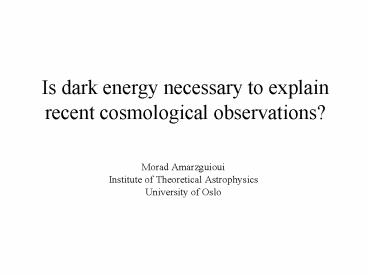Is dark energy necessary to explain recent cosmological observations - PowerPoint PPT Presentation
1 / 21
Title:
Is dark energy necessary to explain recent cosmological observations
Description:
The concordance model. Inhomogeneities in the matter distribution? General ... Concordance model ... Better fit to SNIa than the homogeneous concordance model. ... – PowerPoint PPT presentation
Number of Views:33
Avg rating:3.0/5.0
Title: Is dark energy necessary to explain recent cosmological observations
1
Is dark energy necessary to explain recent
cosmological observations?
- Morad Amarzguioui
- Institute of Theoretical Astrophysics
- University of Oslo
2
Outline
- Theoretical foundations of cosmology
- Observations
- The concordance model
- Inhomogeneities in the matter distribution?
3
General relativity
- Einstein's GR lays the foundations for most of
our understanding of the Universe. - Describes gravity not as a force but as a
curvature of space and time
- Curvature Energy and pressure.
- Gravitational motion particles move freely in
the curved space-time.
4
Cosmological principle
- The field equation cannot be solved generally.
Must make an assumption about the geometry and
distribution of matter. - Cosmological principle The Universe is
homogeneous and isotropic. - Leads to a very simple model for the Universe
The Friedmann-Robertson-Walker (FRW) model.
5
FRW space-time
- The geometry is described by the line element
-
- This leads to the Friedmann equations
-
- Assuming contribution from various energy
components, the first equation can be written as
6
Observations
- Observe radiation emitted by various sources.
- Three main observational sources
- Supernovae of type Ia (SNIa)
- Cosmic microwave backround radiation (CMB)
- Large-scale structure (LSS)
- Evolution of the Universe from emission to
absorption affects the intensity and redshift of
the photons. Observations constrain the
evolution.
7
8
Concordance model
- Combining the three sets of tests gives a best
fit model which is flat and contain only approx.
25 matter. - The remaining 75 are in the form of a mysterious
dark energy.
9
Dark energy
- We don't know what dark energy is. Know only its
properties. - Supernova observations indicate that the
expansion rate of the Universe increases with
time. Dark energy must therefore act repulsively,
causing the expansion to accelerate. - From Friedmann's equations Has negative pressure
with - A candidate The cosmological constant.
10
Cosmological constant
- Introduced by Einstein in 1917 to make his
Universe model static. - Expect such a term to appear naturally in the
field equations. - QFT predicts that there should be vacuum energy
present due to vacuum fluctuations. - Zel'dovich The vacuum energy behaves like the
cosmological constant.
11
Problems
- Fine-tuning problem A naïve calculation of the
vacuum energy gives a value that is at least 120
order of magnitude too large. - Coincidence problem Why are the densities of
vacuum energy and matter of the same order today.
They scale as -
- Leaves only a tiny window of opportunity where
they can be roughly equal. Why today?
12
Is dark energy necessary?
- All values for the cosmological parameters are
derived under the assumption that the Universe is
homogeneous and isotropic. - Instead of introducing additional energy
components, maybe one should allow for more
general matter distributions? - Compatible with the observations without dark
energy?
13
Supernovae and acceleration
- SN observations imply that the expansion rate
increases along the path of the photons
from emission to absorption. - In a homogeneous Universe, where the expansion
rate is the same everywhere, this can only mean
that the expansion rate increases with time. - If we allow for an inhomogeneous Universe, the
increase can be explained as a spatial variation
in the expansion rate along the path. No
accelerated expansion!
14
Spherically symmetric models
- The simplest realistic inhomogeneous model is
spherically symmetric. - Geometry given by the Lemaître-Tolman-Bondi (LTB)
metric - Expansion is generally different in radial and
transverse directions.
15
Field equations
- The Friedmann equations generalize to
- serve the role as free parameters.
- Can define generalized density contrasts for
matter and curvature from the Friedmann equations.
16
Free parameters
- How do we expect and to behave?
- Use data from SNIa, LSS and CMB to constrain the
parameters. The physical parameters probed by
these observations are the expansion rate and the
density parameters. - The physical parameters are related to and
via the Friedmann equations.
17
Qualitative behaviour
- For compatibility with SNIa, the expansion rate
must decrease radially from the observer. - For compatibility with LSS, the density of matter
today must be 0.2-0.3. - For compatibility with CMB, the Universe must be
flat and the expansion rate relatively low
(h0.5). - No tension between these requirements since the
tests probe different spatial regions of the
Universe.
18
Combined
- The expansion rate decreases radially down to a
low and constant value. - The matter density is low near the observer and
increases radially outward to a high and constant
value. - We live inside an underdense bubble in an
otherwise homogeneous Universe!
19
Best-fit model
- Better fit to SNIa than the homogeneous
concordance model. - Have not done an actual fit to the whole CMB
power spectrum. Only to the first peak. - Matter density close to the observer is
.
20
Off-center observers
- Moving the observer away from the center will
change the SNIa and CMB observations. - Anisotropic space-time --gt asymmetric photon
paths --gt additional anisotropies in the CMB
anisotropic relation between magnitudes and
redshift for SNIa. - These effects constrain the off-center placement
to within 15 Mpc from the center.
21
Conclusions
- Inhomogeneous models can to a certain degree
explain the cosmological data without introducing
dark energy. - No accelerated expansion.
- We live inside an underdense region of the
Universe. - Restricted to a radius of 15 Mpc from the center.
- The Copernican principle is violated. We live in
a special place.































